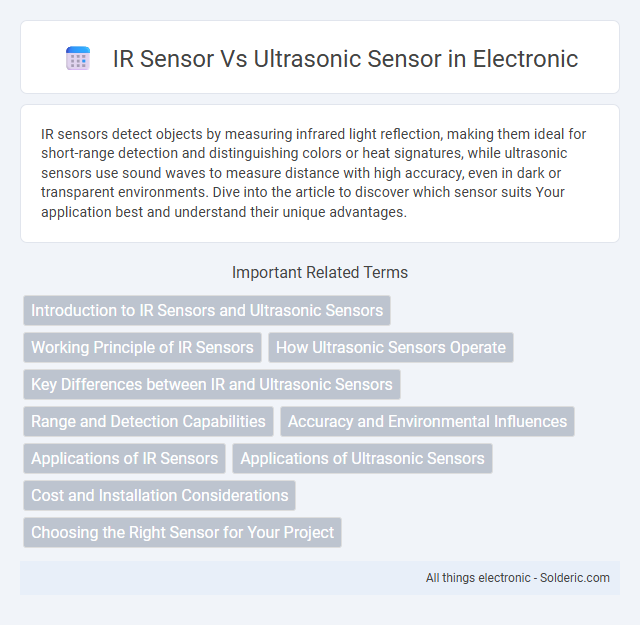IR sensors detect objects by measuring infrared light reflection, making them ideal for short-range detection and distinguishing colors or heat signatures, while ultrasonic sensors use sound waves to measure distance with high accuracy, even in dark or transparent environments. Dive into the article to discover which sensor suits Your application best and understand their unique advantages.
Comparison Table
| Feature | IR Sensor | Ultrasonic Sensor |
|---|---|---|
| Detection Principle | Infrared light reflection | Ultrasonic sound wave reflection |
| Range | Short (typically 2-30 cm) | Medium to long (2 cm to 400 cm+) |
| Accuracy | Moderate, affected by surface color and light | High, less affected by surface color |
| Environmental Sensitivity | Sensitive to ambient light and infrared interference | Unaffected by light; sensitive to temperature variations |
| Applications | Obstacle detection, line following, proximity sensing | Distance measurement, object detection, liquid level sensing |
| Power Consumption | Low | Moderate to high |
| Cost | Low | Moderate to high |
| Output Type | Analog or digital (proximity) | Digital (distance measurement) |
Introduction to IR Sensors and Ultrasonic Sensors
IR sensors detect objects by emitting infrared light and measuring the reflected signals, making them ideal for short-range proximity detection and motion sensing. Ultrasonic sensors use sound waves at frequencies above human hearing to calculate distance by measuring the time delay between emission and echo reception, excelling in long-range and precise distance measurements. Your choice between these sensors depends on the required detection range, environmental conditions, and the type of target object.
Working Principle of IR Sensors
IR sensors operate by emitting infrared light and detecting its reflection off nearby objects, utilizing photodiodes or phototransistors to measure the intensity of reflected IR waves. The distance or presence of an object is inferred based on the amount of IR light received back, which varies with surface characteristics and proximity. This principle contrasts with ultrasonic sensors that rely on sound wave echo timing to determine object distance.
How Ultrasonic Sensors Operate
Ultrasonic sensors operate by emitting high-frequency sound waves that bounce off objects and return to the sensor, allowing it to calculate the distance based on the time-of-flight principle. These sensors are highly effective in various environments because they can detect objects regardless of color, transparency, or surface texture. Your projects benefit from the precision and versatility of ultrasonic sensors, especially in applications requiring accurate distance measurement or obstacle detection.
Key Differences between IR and Ultrasonic Sensors
IR sensors detect objects by measuring infrared light reflection, offering precise short-range detection with sensitivity to surface color and material. Ultrasonic sensors use high-frequency sound waves to measure distance, providing accurate long-range detection regardless of object color or transparency. IR sensors are ideal for proximity sensing in controlled environments, while ultrasonic sensors excel in diverse conditions requiring reliable distance measurement over varied surfaces.
Range and Detection Capabilities
IR sensors typically have a shorter range of up to a few centimeters and excel at detecting objects based on emitted infrared light, making them ideal for close-proximity sensing. Ultrasonic sensors offer a longer detection range, often reaching several meters, by measuring the time it takes for sound waves to bounce back from an object, which allows for more accurate distance measurement in various environments. Your choice between these sensors should consider the required detection distance and the environmental factors affecting their performance.
Accuracy and Environmental Influences
IR sensors offer precise short-range detection with high accuracy in controlled lighting conditions but can be significantly affected by ambient light and surface reflectivity. Ultrasonic sensors provide reliable distance measurements over longer ranges and perform consistently in various lighting environments, though accuracy can be compromised by soft or angled surfaces that absorb or deflect sound waves. Both sensors exhibit distinct environmental sensitivities influencing their measurement precision, with ultrasonic sensors generally outperforming IR sensors in dynamic and outdoor settings.
Applications of IR Sensors
IR sensors are widely used in proximity detection, obstacle avoidance in robotics, and motion sensing for security systems. Their ability to detect infrared radiation enables applications in remote controls, temperature measurement, and night vision equipment. You can rely on IR sensors for precise short-range detection in consumer electronics and automation systems.
Applications of Ultrasonic Sensors
Ultrasonic sensors are widely used in industries for distance measurement, object detection, and level sensing due to their high accuracy and ability to operate in harsh environments. They are essential in automotive parking assistance, robotics navigation, and liquid level monitoring in tanks where precise, non-contact measurement is crucial. Your projects benefit from ultrasonic sensors when reliable detection or ranging is required over varying surface materials and lighting conditions.
Cost and Installation Considerations
Infrared (IR) sensors generally have a lower cost and simpler installation process due to their compact size and minimal wiring requirements. Ultrasonic sensors tend to be more expensive and require careful placement to avoid interference and ensure accurate distance measurements. Cost-effectiveness and ease of installation make IR sensors suitable for basic proximity detection, while ultrasonic sensors are preferred for precise range sensing in complex environments.
Choosing the Right Sensor for Your Project
IR sensors excel in short-range object detection with high precision and low cost, ideal for proximity sensing and line-following robots. Ultrasonic sensors provide accurate distance measurement over longer ranges and perform well in various lighting conditions, making them suitable for obstacle avoidance and level detection. Selecting the right sensor depends on the required detection range, environmental conditions, and specific application needs of the project.
IR sensor vs ultrasonic sensor Infographic

 solderic.com
solderic.com